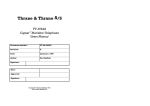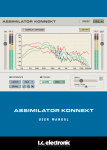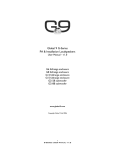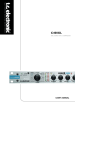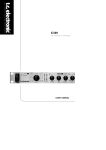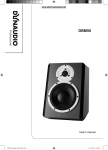Download BLACKSMITH - TC Electronic
Transcript
BLACKSMITH User’s manual 1 2 3 4 5 6 7 Read these instructions. Keep these instructions. Heed all warnings. Follow all instructions. Do not use this apparatus near water. Clean only with dry cloth. Do not block any ventilation openings. Install in accordance with the manufacturer’s instructions. 8 Do not install near heat sources such as radiators, heat registers, stoves, or other apparatus (including amplifiers) that produce heat. 9 Do not defeat the safety purpose of the polarized or grounding-type plug. A polarized plug has two blades with one wider than the other. A grounding type plug has two blades and a third grounding prong. The wide blade or the third prong are provided for your safety. If the provided plug does not fit into your outlet, consult an electrician for replacement of the obsolete outlet. 10Protect the power cord from being walked on or pinched particularly at plugs, convenience receptacles, and the point where they exit from the apparatus. 11Only use attachments/accessories specified by the manufacturer. 12 Warning! • To reduce the risk of fire or electrical shock, do not expose this equipment to dripping or splashing and ensure that no objects filled with liquids, such as vases, are placed on the equipment. • This apparatus must be earthed. • Use a three wire grounding type line cord like the one supplied with the product. • Be advised that different operating voltages require the use of different types of line cord and attachment plugs. • Check the voltage in your area and use the correct type. Please refer to the following table: Use only with the cart, stand, tripod, bracket, or table specified by the manufacturer, or sold with the apparatus. When a cart is used, use caution when moving the cart/apparatus combination to avoid injury from tip-over. 13Unplug this apparatus during lightning storms or when unused for long periods of time. 14Refer all servicing to qualified service personnel. Servicing is required when the apparatus has been damaged in any way, such as power supply cord or plug is damaged, liquid has been spilled or objects have fallen into the apparatus, the apparatus has been exposed to rain or moisture, does not operate normally, or has been dropped. • • • • • Voltage Line plug according to standard 110-125 V UL817 and CSA C22.2 no 42. 220-230V CEE 7 page VII, SR section 107-2-D1/IEC 83 page C4. 240V BS 1363 of 1984. Specification for 13A fused plugs and switched and unswitched socket outlets. This equipment should be installed near the socket outlet and disconnection of the device should be easily accessible. To completely disconnect from AC mains, disconnect the power supply cord from the AC receptacle. The mains plug of the power supply shall remain readily operable. Do not install in a confined space. Do not open the unit – risk of electric shock inside. Caution: You are cautioned that any change or modifications not expressly approved in this manual could void your authority to operate this equipment. Service • There are no user-serviceable parts inside. • All service must be performed by qualified personnel. a EN Important Safety Instructions EMC / EMI & Certificate of conformity EMC/EMI This equipment has been tested and found to comply with the limits for a Class B Digital device, pursuant to part 15 of the FCC rules. These limits are designed to provide reasonable protection against harmful interference in residential installations. This equipment generates, uses and can radiate radio frequency energy and, if not installed and used in accordance with the instructions, may cause harmful interference to radio communications. However, there is no guarantee that interference will not occur in a particular installation. If this equipment does cause harmful interference to radio or television reception, which can be determined by turning the equipment off and on, the user is encouraged to try to correct the interference by one or more of the following measures: • Reorient or relocate the receiving antenna. • Increase the separation between the equipment and receiver. • Connect the equipment into an outlet on a circuit different from that to which the receiver is connected. • Consult the dealer or an experienced radio/TV technician for help. For Customers in Canada: This Class B digital apparatus complies with Canadian ICES-003. Cet appareil numérique de la classe B est conforme à la norme NMB-003 du Canada. b Table of contents Introduction EN Important Safety Instructions & Certificate of Conformity....................................... a-b Table of Contents........................................................ 3 Introduction.................................................................. 4 Quick Setup Guide...................................................... 5 Operation Front panel.................................................................. 7 RC-4.......................................................................... 14 Rear panel................................................................. 15 Appendix General Protection mode.......................................... 19 Heat Protection mode............................................... 19 Signal Flow Diagram................................................. 20 Technical Specifications............................................ 21 TC Electronic, Sindalsvej 34, DK-8240 Risskov – [email protected] English Version - Revision 1 Prod. No: 606150111 3 Introduction Congratulations on the purchase of your last bass-amp for big stage use. Blacksmith unites immense power and versatility, delivering a sound so massive that it is guaranteed to cover any demand imaginable. The raw power combined with nice features such as presets, compression and TubeTone known from other TC Electronic bass amplifiers will keep the smile on your face for a very long time. Bass amp 2.0 has just reached a high point. Blacksmith unites immense power and versatility, delivering a sound so massive that it’s guaranteed to pierce through any mix – with ease! Blacksmith - with Blacksmith behind you, power is not an issue. Large clubs, major venues or full-scale stadiums: No matter which stage you enter – you’re covered all the way. You’ll be in control of a massive 1600 watts, delivering a huge bass tone that will follow your slightest move while playing those hard-rocking bass lines and hammering riffs. Tone Shaping Overdose – Blacksmith doesn’t just give you a set of rough tools for basic sound sculpting; it provides you with a full arsenal of tone-shaping tools, allowing you to tailor any sound imaginable. The primary tone-shaping tool is the 4-band EQ that gives you full control over Bass, Low-mid, High-mid and Treble for instant creation of your dream tones. In short, you can make crude tonal changes or fine-tune subtle nuances with surgical precision depending on the situation. On top of that, three extremely versatile tools allow you to gracefully enter the tonal corner of bass heaven: SpectraComp, TubeTone and TweeterTone. SpectraComp – offers ‘per-string’ multi-band compression. In short, your sound gets compressed evenly across all strings without having the dynamics of your playing destroyed. This is the way bass compressors should always have been done. TubeTone – is all about that special, vintage feel. Turn it up just a bit for a touch of subtle tube warmth, give it another notch to add genuine tube grind or crank it all the way up to get a roaring, in-your-face overdrive! With TubeTone, you get a painstaking recreation of both the tube preamp and power amp sections. Putting a single tube in a preamp will not do the job – TubeTone will! TweeterTone – is your tool of choice whenever you go for a modern, crisp sound that will take your sound to new heights – frequency-wise! Perfect for capturing that distinct and razor-sharp slap sound that instantly makes the crowd embrace the bass! 4 Built-in Tuner – Once you have tried this, there’s no turning back. The idea of having an internal chromatic bass tuner is as simple as it is brilliant. The tuner is always ‘on’, which allows you to monitor your pitch status at all times – and to tune up swiftly between tunes if needed. Most amps come with a ‘tuner out’, but why have a rack tuner clutter up your rig? Why not build it in right from the start? There are literally no downsides, so it was really a no-brainer! User memories – If you’ve ever used different basses or change playing style during shows, you know that a few amp presets would be welcome. Blacksmith offers three on-board user memories, allowing you to switch easily between 4 and 5-string basses, Rickenbackers and Fenders for that matter. You can also create three entirely different tones for one bass – e.g. overdrive using TubeTone, crisp and cutting slap sound using SpectraComp and TweeterTone and a classic, old-school vintage tone. In short: Have it your way – three times! POWER!!! – Power is not an issue – it is just something you have with Blacksmith. 1600 watts of raw, hard-punching power will keep you loud and still leave plenty of headroom for ‘even louder’ in any band setting on any stage! Also, Blacksmith is capable of operating at 8, 4 or 2 Ohms, so, ultimately, you could fire up four RS410 cabinets – that’s 16 x 10”, or 8.7 square foot of speaker cones blasting air in your direction! You better put that foot on the monitor to keep standing! Please note - We reserve the rights to change the contents of this manual at any time. The latest manual revision can always be downloaded from www.tcelectronic.com. If you need additional information and support, be sure to visit the TC Support Portal: www.tcelectronic.com/support 5 EN Introduction Quick Setup guide If you just can’t wait… Here are a few quick steps to get you playing within minutes. Unpacking • Unpack your BLACKSMITH amp. • The box should contain the following items: – BLACKSMITH amplifier – Power Cable – Manual. • Inspect all items for signs of transit damage. In the unlikely event of this having occurred, inform the carrier and supplier. • Keep all the packaging if damage has occurred, as this will show evidence of excessive handling force. • It is also a good idea to keep the packaging for future transportation. Setting up • Connect the Speaker Out of the amplifier to your cabinet using a Speakon cable. • Blacksmith can run any cabinet combination with a minimum load of 2 Ohm. To get the optimum performance from the amplifier, make sure to select the correct Load Impedance on the back plate before powering up the amplifier. Notice that the amplifier will NOT be damaged if a wrong Load Impedance setting is selected, but a protection mode may be invoked. (please refer to page 19 for more information) • • • • • Connect the power cable and power up. Connect your bass to the input jack on the front panel. Adjust the input gain using the GAIN knob. Adjust the output volume using the MASTER knob. Play! • RC-4 is an optional pedal with four footswitches that can use to switch between three memory locations and also to mute for tuning purposes. This pedal also shows tuner information. Be sure to check www.tcelectronic.com for latest news about these and other TC products. 6 Operation – Front Panel EN Front Panel 1 – INPUT You can connect an active or passive bass to this ¼” input jack. The BLACKSMITH input stage is designed to adapt to any type of pickup. 2+3 – GAIN & OVERLOAD LED The input gain should be set to the highest possible level without overloading the input stage. To find the correct setting, simply plug in your bass, play and turn up the GAIN knob until the OVERLOAD LED occasionally lights up. Then reduce the gain slightly. When set, simply turn up the MASTER volume knob to start playing. 4 – TONE Controls BLACKSMITH has four tone controls: Bass, Lo-mid, Hi-mid and Treble. These controls have been tuned carefully to address four relevant bass frequency areas, and should allow you to dial in your sound with ease. As you know, each instrument has its own sound characteristics. If you feel that your BLACKSMITH’s tone controls don’t grab exactly the frequencies your particular instrument requires, you can change the center frequencies of the four EQ bands. Changing Tone Control Frequency You can change the control frequencies of all four frequency bands. This is sometimes referred to as “parametric bands” or “sweepable”. Normally, the BASS, LO-MID, HI-MID and TREBLE knobs are used to set the gain of each EQ band. To change the center frequency of an EQ band, press the SHIFT button once and then adjust a band’s center frequency by turning its knob. 7 Operation – Front Panel Example: Press SHIFT and turn the LO-MID knob to change the center frequency of that control. Sometimes “sweepable” tone controls can be a bit tedious to work with. Here is an easy step-by-step guide to adjusting BLACKSMITH’s Low-mid band to your bass and setup: • • • • 8 Boost the LO-MID band – the more you boost, the easier it is to find the right frequency. Hit the SHIFT button to get access to the center frequency of the EQ bands. Now, while playing your bass, slowly turn the LO-MID knob to sweep the low-mid frequency across the frequency range. When you find the frequency that you prefer to control, simply hit the SHIFT button again to switch back to gain control and set the right amount of low-mid gain. While BLACKSMITH is in Shift mode, the SHIFT button will be blinking to remind you that you are in Shift mode. When you haven’t been using the BLACKSMITH’s front panel controls for about twenty seconds, the LED will flash rapidly, and BLACKSMITH will automatically return to normal mode. Gain and Frequency Ranges Bass Freq range: 71 Hz to 1120 Hz (default: 200) Bass Gain range: -24 dB to +15 dB (Shelving type) Low Mid Freq range: Low Mid Gain range: (Fixed 2.1 oct.) 100 Hz to 1600 Hz (default: 400) -24 dB to +15 dB High Mid Freq range: High Mid Gain range: (Fixed 2.1 oct.) 200 Hz to 3150 Hz (default: 800) -24 dB to +15 dB Treble Freq range: Treble Gain range: (Shelving type) 400 Hz to 6300 Hz (default: 4000) -24 dB to +12 dB 5 – SPECTRACOMP™ Turn the knob to adjust the amount of SpectraComp compression. SpectraComp™ uses a so-called spectral or multi-band approach to compression, allowing for individual compression of the low, mid and high frequency bands. Multiband compression allows a significantly smoother and more transparent compression without killing dynamics or tone. SpectraComp™ is an advanced compressor, optimized to get the best from a bass signal. If you simply want to hear it just turn the knob while playing. If you want to know a bit more about what is going on behind the scenes, please read the following section. SpectraComp In Depth Gain Reduction / Compression Meter When using SpectraComp™, the light-ring around the SPECTRACOMP knob doubles as a compression meter, showing you how much compression is applied to the signal. Spectral Compression vs. Full Band Compression Virtually any compressor on the market for bass is based on a “full band” principle, meaning that the compressor will respond and compress identically across the full (20 Hz to 20 kHz) frequency range. From the low E (or B) string to the G string: The electric bass has a very wide dynamic range. When using standard compressors, the low E string will – due to its higher energy – control when and how the compressor responds to and shapes the entire signal. The typical result is that either the G string is not compressed at all or that – just when the G string starts to sound right –, the low E string is compressed too strongly. In other words: You are constantly dealing with a tight and difficult compromise. With Spectral Compression, the BLACKSMITH amplifier uses a different approach that allows for independent compression of the Low, Mid and High frequency areas. This way, the right amount of compression is added to the individual strings of your bass, resulting in a smoother and much more transparent compression. Auto Make-up Gain As compression by nature reduces the loudest parts and peaks of the signal, you may feel that many conventional compressors “eat” the level of your signal, resulting in a lower output volume. SpectraComp™ automatically compensates for compression gain reduction, giving you an even output volume. 9 EN Operation – front panel Operation – front panel 5 – TWEETERTONE™ (in Shift Mode) Many heads and cabinets include a so-called “L pad” HF control on the back side of the cabinet. This control normally sets the level of the tweeter in the cabinet and is used to adjust the level of high frequencies. TweeterTone is a far more intuitive and much better way of adjusting the high frequency content. By using TweeterTone, you do not simply turn the tweeter up and down in level – you also get a much more musical and pleasant HF adjustment. And instead of having to fumble around on the back of the cabinet, you can simply use the TweeterTone knob right there on the front panel. Finally, TweeterTone is stored as part of your presets. This allows you to adjust the level of HF with the rest of your sound and thus go from a round and warm vintage sound to a sparkling and crisp slap-setting – simply by hitting a preset switch. 6 – TUBETONE™ TubeTone™ allows you to alter the “personality” and sound of your BLACKSMITH. The effects you can achieve range from a small touch of classic tube amp response and character through obvious, but pleasant “tube attitude” to highly overdriven. Contrary to many tube simulations, TubeTone™ recreates both the entire preamp section (located before the tone control section) and the power amp section (located after the tone controls). Not only does this give you the most realistic and flexible recreation of the actual tube sound and response, but it also allows you to alter the behavior and character of 10 TubeTone™ through the BLACKSMITH tone controls as you would on an actual tube amp. The TUBETONE knob adjusts the amount of both the preamp and the power-amp tube simulation. 6 – PRESET LEVEL (in Shift Mode) Press SHIFT and then turn the TUBETONE knob to adjust the level of the currently selected MEM/preset. When you haven’t been using the BLACKSMITH’s front panel controls for about twenty seconds, the LED will flash rapidly, and the BLACKSMITH will automatically return to normal mode. In normal mode, the TUBETONE knob controls the intensity of the Tubetone™ effect. Range: -12 dB to 0 dB Operation – front panel 8 – MUTE The MUTE button mutes both the speaker and the balanced output. This means that you can tune up with no sound going to your own rig or to the PA. 9 – SHIFT The SHIFT button is used to access the secondary functions marked with red text on BLACKSMITH’s front panel. The following controls have secondary functions: Normal mode EQ (1-4) SPECTRACOMP TUBETONE Shift mode (press SHIFT) EQ Bands Center Frequencies TweeterTone adjust Preset/Memory Level Settings When you haven’t been using BLACKSMITH’s front panel controls for about twenty seconds, the BLACKSMITH will return to normal mode, where the knobs control the primary functions printed in white. 10 – MEM 1/2/3 BLACKSMITH features three user memories which allow you to effortlessly store and recall your favorite settings. Storing settings is extremely simple: – Dial in the settings that you like. – Press and hold one of the MEM buttons for circa two seconds. – When the MEM button blinks, your settings have been stored. – To recall a MEM setting, simply press the corresponding MEM button once. EN 7 – MASTER Use the MASTER level knob to set the overall output level of the amp. The master level also controls the level of the headphone output. What is stored? Any parameter that is operated by a light ring knob is stored. This means the settings of all front panel controls – apart from the Master level, the SHIFT and MUTE buttons – are stored. Why MEM settings? Even though many bass players tend to play with the same sound most of the time, a lot of them do have a couple of different basses, playing styles, pickup settings or other factors that require amp settings to be changed. We figured that it would be handy to simply push one button instead of fiddling with several knobs. Remote Control BLACKSMITH’s optional remote control – “RC-4” – allows for floor recall of all three MEM settings as well as mute and tuner display. 11 Operation – front panel 11 – TUNER BLACKSMITH is equipped with a fully chromatic, high accuracy bass tuner. The tuner is always active, whether BLACKSMITH is in Mute mode or not. Here is how you read the display: The played note is shown on the left side of the display. On the right side of the display, – a circle indicates that the note is in tune. – an arrow pointing right indicates that the note is too low and should be tuned up. – an arrow pointing left indicates that the note is too high and should be tuned down. Too low – tune up Too high – tune down In tune Sharp notes: C#, D#, F#, G# and A# are indicated as follows: Example – A# The tuner also offers a Mute mode with additional tuner information. To activate Mute mode, simply press the MUTE button. Now the BASS tone control turns into a high resolution pitch indicator supporting the Note and Arrow field of the tuner. 12 Too low – tune up Too high – tune down In tune Tuner information is also displayed in the optional RC-4 footswitch. Yes, this is correct: If you have a RC-4 footswitch, you do no longer need a separate tuner. Please refer to the manual section “RC-4” to learn more about this footswitch. Operation – front panel Tuner Reference This is how you select the tuner reference frequency: – If BLACKSMITH is switched on, switch it off. – Press and hold the MUTE button during power up. – BLACKSMITH now powers up in Tuner reference mode, which is illustrated by an “R” in the Display (see illustration below). EN BLACKSMITH’s default tuner reference is 440 Hz – just like any other tuner. However, you can select any reference frequency between 438 and 445 Hz. – Press the MUTE button to exit Tuner Reference mode. Please note that the tuner’s reference frequency is remembered even after powering the unit off. Tune Reference mode – Dial the BASS tone control to alter the tuner reference. The center position equals 440 Hz, and each LED represents one Hertz. So to set the tuner reference frequency e.g. to 438 Hz, turn the BASS knob counter-clockwise until the second LED on the left lights up. 13 RC-4 The optional RC-4 footswitch not only allows you to remotely access the BLACKSMITH’s three memory locations (MEM 1/2/3), but also to mute the signal for silent tuning and even view the tuner information. No power-supply is needed for the RC-4 as it receives its power from BLACKSMITH. 1 – Memory Switches 1, 2 and 3 Press one of the three numbered buttons to recall the settings stored in the associated MEM location. A green light ring around the switch indicates that this MEM setting has been recalled (activated). – Note that you can only recall a MEM setting if a setting has actually been stored in a memory location. – Also note that as soon as you change one of the stored settings on the BLACKSMITH front panel, the green light ring on the footswitch will be unlit. This indicates that the positions of the front panel knobs no longer correspond to the stored settings. 2 – MUTE button Press the M(ute) button to mute the BLACKSMITH’s outputs. 14 This is useful for tuning or e.g. unplugging/changing your bass. The MUTE button also mutes the BLACKSMITH’s balanced output, allowing you to tune silently, even when connected to the PA system. 3 – DISPLAY The display always indicates tuner information in a couple of different ways. The detected note is shown on the left side. On the right side of the display, a circle indicates that the note is in tune, an arrow pointing to the right indicates that the note should be tuned up, and an arrow pointing to the left indicates that the note should be tuned down. In addition to these indications (that are also shown on the BLACKSMITH tuner display), a line of nine dots below the display indicates how far from the target pitch the currently played note is. When only the center dot is lit, the note is in tune. Too low – tune up Too high – tune down In tune Rear Panel EN Rear Panel SERIAL NO. SPEAKER OUT CLASS 2 WIRING Minimum Load: 2 Ohm LOAD IMPEDANCE CAUTION RISK OF ELECTRIC SHOCK DO NOT OPEN WARNING TO REDUCE THE RISK OF FIRE OR ELECTRIC SHOCK DO NOT EXPOSE THIS EQUIPMENT TO RAIN OR MOISTURE. AVIS RISQUE DE CHOC ELECTRIQUE-NE PAS OUVRIR 4 OHM OR ABOVE 2 OHM ALLOWED SPEAKER FREE OPERATION R 1600W BASS AMPLIFIER C US FILE# 186633 BLACKSMITH MAINS IN MADE IN DENMARK UTILITY ZONE MAINS GROUND MUST BE CONNECTED REMOTE IN DIGITAL OUT 5V/100mA PRE/POST PREAMP LINE DRIVER OUT transformer balanced SEND RETURN AES/EBU 96kHz (S/PDIF Compatible) EFFECTS LOOP SEND / RETURN PRE POST PRE-AMPLIFIER 15 Operation – Rear Panel 1 – MAINS IN – Power In & POWER switch Make sure that the voltage of the power grid you are connecting to matches your BLACKSMITH model. The 115 V model can handle voltages between 100 V and 120 V. The 230 V model can handle voltages between 220 V and 240 V. 4 Ohm 2 Ohm HOLD TO STORE MEM 1 MEM 2 MEM 3 SHIFT BLACKSMITH 4 Ohm HOLD TO STORE MUTE MEM 1 MEM 2 MEM 3 SHIFT BLACKSMITH 1600W CLASS-D BASS AMPLIFIER INPUT HOLD TO STORE MUTE BASS LO-MID HI-MID CENTER TREBLE SPECTRACOMP TUBETONE TWEETERTONE PRESET LEVEL TM TM TM MASTER If you intend to use Blacksmith with a 2 Ohm cabinet configuration, please select the 2 Ohm mode using the small switch placed next to the Speakon connectors. (Default setting for the switch is 4 Ohm.) Configurations of 4 Ohm and above should be run in the 4 Ohm mode. Selecting the wrong impedance mode will not damage your amp, but may cause BLACKSMITH to go into Protection Mode, thus muting the speaker outputs. Please see the general Protection Mode Section for further information. 16 MEM 3 SHIF I ACTIVE / PASSIVE PICK-UP BLACKSMITH GAIN BASS LO-MID HI-MID CENTER TREBLE SPECTRACOMP TUBETONE TWEETERTONE PRESET LEVEL TM TM TM MASTER ACTIVE / PASSIVE PICK-UP BLACKSMITH SERIAL NO. 0012 SERIAL NO. 0012 SERIAL NO. 0012 HANDCRAFTED IN DENMARK HANDCRAFTED IN DENMARK HANDCRAFTED IN DENMARK The ground pin of the power supply unit must be connected in order to avoid voltage differences between e.g. the PA and the BLACKSMITH. 2/3 – SPEAKER OUT & LOAD IMPEDANCE SWITCH Use the Speakon SPEAKER OUT connectors for connecting speaker cabinets. Use quality speaker cables only. Do NOT use instrument cables! MEM 2 INPUT O I GAIN MEM 1 BLACKSMITH 1600W CLASS-D BASS AMPLIFIER INPUT O ACTIVE / PASSIVE PICK-UP BLACKSMITH 4 – REMOTE IN Use the REMOTE IN jack to connect the BLACKSMITH to the optional footswitch/remote “RC-4”. The RC-4 gives you access to the three memory locations, the mute function, and has tuner indication as well. The RC-4 5 – DIGITAL OUT Use the DIGITAL OUT to connect BLACKSMITH’s digital output stage directly to a digital audio device, such as a computer’s audio interface. This way, you can record your bass sound GAIN BASS LO-MID HI-MID CENTER TREBLE 6 – INSERT PREAMP I/O – Effects Loop/Break point These jacks provide a break point between BLACKSMITH’s preamp section (which includes SpectraComp™, Tone controls and the TubeTone™ module) and the power amp section. This break point can be used as a regular serial effects loop for inserting e.g. modulation effects or other external devices. straight into Pro Tools, Logic or any other DAW application. The digital output signal is in 96 kHz/24 Bit AES/EBU format. This ensures the highest possible resolution and quality of your recorded bass signal. To determine where in the signal chain the signal for the digital output should be tapped, use the PRE/ POST switch located right beside the LINE DRIVER OUT jack on the BLACKSMITH’s rear panel. Your bass signal is present on both Left and Right digital channel. Setting up for recording: In order to record straight from BLACKSMITH’s digital output, follow these steps: – Connect BLACKSMITH’s DIGITAL OUT to your DAW. – Set your DAW to sync/slave to “external clock”. – Hit the record button in your DAW and start playing. CLASS 2 WIRING Minimum Load: 2 Ohm SPDIF Compatibility While a simple XLR to RCA converter may suffice to allow recording through an SPDIF interface, please note that AES/ EBU and SPDIF have different level and impedance specifications, which in some cases can cause compatibility problems. SERIAL NO. SPEAKER OUT CAUTION RISK OF ELECTRIC SHOCK DO NOT OPEN WARNING TO REDUCE THE RISK OF FIRE OR ELECTRIC SHOCK DO NOT EXPOSE THIS EQUIPMENT TO RAIN OR MOISTURE. AVIS RISQUE DE CHOC ELECTRIQUE-NE PAS OUVRIR ALLOWED SPEAKER FREE OPERATION Linking Two Amps The break point may also be used to link two BLACKSMITH units together to achieve even more power. – Use a standard ¼” jack instrument cable to connect the first BLACKSMITH SEND (the upper) to the second BLACKSMITH’s RETURN (the lower jack). – Plug your bass into the INPUT jack on the first BLACKSMITH and adjust your sound using the controls on this BLACKSMITH. – Set the volume using the MASTER volume knobs of both amps. You now have – let us say “enough” amplification power at your fingertips! LOAD IMPEDANCE LOAD IMPEDANCE CAUTION RISK OF ELECTRIC SHOCK 4 OHM OR ABOVE DO NOT OPEN 2 OHM WARNING TO REDUCE THE RISK OF FIRE OR ELECTRIC SHOCK DO NOT EXPOSE THIS EQUIPMENT TO RAIN OR MOISTURE. AVIS RISQUE DE CHOC ELECTRIQUE-NE PAS OUVRIR R 4 OHM OR ABOVE 2 OHM ALLOWED SPEAKER FREE OPERATION R C US FILE# 186633 C US FILE# 186633 MAINS IN MAINS IN MAINS GROUND MUST BE CONNECTED MAINS GROUND MUST BE CONNECTED 1600W BASS AMPLIFIER BLACKSMITH MADE IN DENMARK UTILITY ZONE If you want to record with an analog signal instead, you may also use the BLACKSMITH’s balanced output signal from the LINE DRIVER OUT jack. CLASS 2 WIRING Minimum Load: 2 Ohm SPEAKER OUT SERIAL NO. REMOTE IN DIGITAL OUT 5V/100mA PRE/POST PREAMP SEND BLACKSMITH MADE IN DENMARK UTILITY ZONE LINE DRIVER OUT REMOTE IN DIGITAL OUT transformer balanced 5V/100mA PRE/POST PREAMP RETURN AES/EBU 96kHz (S/PDIF Compatible) 1600W BASS AMPLIFIER LINE DRIVER OUT transformer balanced SEND RETURN EFFECTS LOOP SEND / RETURN PRE POST PRE-AMPLIFIER AES/EBU 96kHz (S/PDIF Compatible) EFFECTS LOOP SEND / RETURN PRE POST PRE-AMPLIFIER Please see relevant setup example on the following page. 17 EN Operation – rear panel Operation Rear Panel “LINK” 4 Ohm 4 Ohm Send HOLD TO STORE MEM 1 MEM 2 MEM 3 SHIFT BLACKSMITH HOLD TO STORE MUTE ACTIVE / PASSIVE PICK-UP BLACKSMITH SERIAL NO. 0012 HANDCRAFTED IN DENMARK MEM 1 MEM 2 MEM 3 SHIFT BLACKSMITH 1600W CLASS-D BASS AMPLIFIER INPUT MUTE 1600W CLASS-D BASS AMPLIFIER INPUT GAIN BASS LO-MID HI-MID CENTER TREBLE SPECTRACOMP TUBETONE TWEETERTONE PRESET LEVEL TM TM TM MASTER O O I I Return ACTIVE / PASSIVE PICK-UP BLACKSMITH GAIN BASS LO-MID HI-MID CENTER TREBLE SPECTRACOMP TUBETONE TWEETERTONE PRESET LEVEL TM TM TM MASTER SERIAL NO. 0012 HANDCRAFTED IN DENMARK BLACKSMITH’s MUTE button mutes both the speaker and headphones outputs. This means that you can tune up with no sound going to your own rig or to the PA. BLACKSMITH’s balanced output has been designed with the utmost care for the sound. This is achieved through a galvanic isolated transformer coupling. The active design by far outperforms most standard DI boxes around, and it is capable of driving long cable hauls. No phantom power is required. Ventilation Be sure not to cover the black cooling plate of the BLACKSMITH amplifier! Insufficient ventilation may cause the amplifier’s temperature to increase. Example: 1600 W power per stack. The left head controls both stacks. 8 – LINE DRIVER OUT – Balanced Line Out Use the LINE DRIVER OUT jack to connect your BLACKSMITH to the PA when you play on stage or to connect it to a recording device when you are in the studio. To determine where in the signal chain the signal for the balanced output should be tapped, use the PRE/POST switch (7), located right next to the LINE DRIVER OUT jack. 18 If your BLACKSMITH is insufficiently ventilated, it may go into Heat Protection mode, which is indicated by an “H” on the front panel display. Please read more on the following page. Protection mode BLACKSMITH is equipped with an intelligent protection system, ensuring that the amp does not suffer or malfunction if operated wrongly or in extreme environments. General Protection mode If the BLACKSMITH’s display indicates “P”, the amp is in Protection mode. Protection mode is invoked if for some reason a short-circuit situation occurs. In Protection mode, the speaker outputs are shut off so that the speakers cannot be damaged by a shortcut. The balanced output, digital recording out and the effects loop, however, are still passing audio in Protection mode. To remedy the problem, try turning off your BLACKSMITH for a minute and then turn it on again. If the display still indicates “P”, you will have to send your BLACKSMITH to a qualified service-center for inspection. Heat Protection Mode If the display indicates an “H”, the amp is too hot. This is rarely seen, but a few extreme situations can invoke this mode: a) If the amplifier is used in an environment that is too hot, or if proper ventilation is not ensured. b) The Load Impedance switch on the amplifier’s back plate must match the load of the connected cabinet configuration. If the Load Impedance switch is set to 4 Ohm and the amplifier is run at high levels over a long period of time with a 2 Ohm speaker configuration, the amplifier may enter Heat Protection mode. In – – – – both situations, proceed as follows: Turn off the amplifier. Solve the issues. Allow the amplifier to cool off for a few minutes. Turn on the amplifier again. Notice that due to Blacksmiths protection features the amplifier will NOT be damaged if a wrong Load Impedance setting is selected. 19 EN Appendix – Miscellaneous Appendix – signal flow DIGITAL RECORDING OUT “LINK” “LINK” INPUT GAIN MUTE SPECTRA COMP TUBETONE PRE TONE CONTROLS TUBETONE POST TWEETER TONE PRESET LEVEL ACTIVE POWER MANAGEMENT MASTER VOLUME “LINK” TUNER POWER AMP IN RETURN JACK “LINK” PREAMP OUT GALVANIC ISOLATION WITH DI DRIVER DI 20 SEND POWER AMP Input Section Input connector Input impedance Gain range Tone controls Bass Low Mid High Mid Treble 1/4” jack 1 MOhm / 100 pF -96 to 32 dB Default Freq: 200 Hz (range: 71-1120 Hz, Gain: +15/-24 dB) - Shelving type. Default Freq: 400 Hz (range: 100-1600 Hz, Gain: +15/-24 dB) Default Freq: 800 Hz (range: 200-3150 Hz, Gain: +15/-24 dB) Default Freq: 4000 Hz (range: 400-6300 Hz, Gain: +15/-24 dB) - Shelving type. Power rating 1600 W (4500 W Peak) 2 Ohm / >4 Ohm setting Recessed Toggle Switch Balanced output Max. Output Transformer Balanced XLR, Pre/Post Pre-amp +0 dBu Optimal Load Impedance 600 Ohm Preamp out 1/4” Jack, Balanced Output, Max Output Level = +8 dBu Power amp in 1/4” Jack, balanced input, impedance = 10 kOhm, Max Input Level = +8 dBu Tweeter Tone -12 to 12, L-PAD Cabinet Recreation Digital Recording out Balanced XLR, AES/EBU, (24 Bit) Tube Tone 0 to 12, Tube amp Recreation Remote connection 5 pin DIN, Cable with shield Spectra Comp 3 band Spectral Compression Preset Level -12 dB to 0 gain attenuation Operating/Storage Temperature 0° C to 50° C / -30° C to 70° C User Memories 3 memory locations storing all front panel controls except Mute & Master Level Humidity Max. 90 % non-condensing Dimensions 483 x 412 x 178 mm / 19” x 16.2” x 7” Weight 12 kg / 26.5 pounds Finish Anodized aluminum front Plated and painted steel chassis Tuner Tuning range Chromatic, constant on A0 (27.50 Hz) to E5 (659.26 Hz) Mute Mutes Speaker out and Balanced out Mains supply 100-120V~ or 220-240V~ 50/60 Hz (200 W @ 1/8 Power) Speaker out 2x SpeakonTM EN Appendix – Technical specifications Due to continuous development, these specifications are subject to change without notice. 21



































